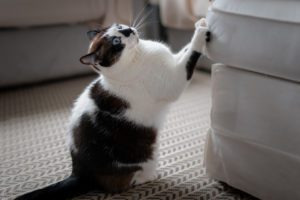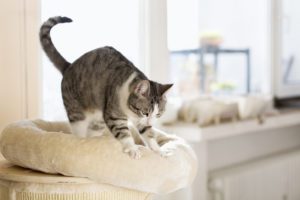5 Reasons Why Cats Scratch Furniture
5 Reasons Why Cats Scratch Furniture in Amesbury, MA
If your feline friend has been scratching up your furniture, chances are that you’re frustrated and baffled—but you’re not alone. Many cat owners can’t seem to find the reason why their pets are destroying furniture, especially if their cats already have toys and scratching posts.
In reality, cats scratch our furniture because they’re bored, not just to sharpen their claws. They also do it as a way of marking territory, stretching, or getting your attention for a good playtime session. This article will show you what your cat is trying to tell you by scratching your furniture and how to stop them from doing so.

1. Sharpening Claws
One of the main reasons cats scratch furniture is to keep their nails sharp and in good condition. Just like human’s nails, cat’s claws are made from keratin. Unlike human nails, however, cat’s claws peel off in layers. Scratching is an activity that allows cats to remove old parts of their claws while sharpening the new layers. What’s left behind after a scratching session is a nice, new, sharp claw that cat’s can use for their daily activities.
Cat’s claws must remain sharp at all times. Since they are retractable, this sharpness does not prevent them from walking. In fact, it helps nourish the natural need to hunt. When in the wild, cats must hunt for food as well as climb trees to escape potential dangers. Sharp claws assist in these needs. So, the habit of scratching (even if it’s on your furniture) is actually an instinctual desire to maintain healthy, sharp, new nails.
2. Stretch Muscles
Don’t you love the feeling of a good, full body stretch? Turns out, cats do too. Scratching allows cats a relieving, full body stretch. It also increases blood flow and helps get muscles moving again after a long afternoon nap.
Like humans, cats experience decreased blood pressure and muscle paralysis while sleeping. Since cats can sleep anywhere between 14-16 hours per day, that’s a lot of down time for their bodies. Stretching reactivates those muscles, increases blood pressure and blood flow, and helps your cat to feel more alert.
A cat stretches when they rise on their hind feet, arch their back, extend their legs, then release their claws. Unfortunately for you, this body reactivation may mean some scratch marks on your furniture.

3. Mark Territory
Cats are territorial animals. They often scratch furniture to leave behind their scent and mark their territory, letting people know they are the boss of the house. This is especially common in multi-cat households. By scratching, cats are communicating to other cats that this space is taken, and they should not trespass.
To get into the specifics, when cats scratch to mark their territory, they are actually releasing a unique smell. Scent and sweat glands are located between the pads of cat’s feet, and these mix together to create that smell. As cat’s scratch down a surface, a few things happen:
- The cat’s unique scent is deposited on that surface.
- Old, discarded parts of the claw are left behind.
- A strong visual and unique scent sends a territorial message to other cats.
Marking territory can also be a sign that your cat is stressed, insecure, or threatened. Closely watch your cat’s behaviors while scratching to determine if these factors may play a role.
4. Relieve Boredom
Some people find this hard to believe, but scratching can be a very satisfying experience for cats. The tactile sensation of scratching and clawing into something feels good. If a cat is scratching furniture instead of an approved surface, it might be because that surface isn’t providing enough satisfaction. If you suspect that your cat might be scratching unwanted surfaces due to boredom, check out some of these boredom-busting scratching post tips:
- Make sure your cat’s scratching post is long and sturdy so your cat can lean its full weight against the post while stretching or scratching.
- Many cats prefer sisal-covered posts instead of carpet. Re-evaluate the texture of your cat’s scratching post.
- Place the scratching post in a location where the cat likes to scratch. If it is out of sight, then it is out of mind for your cat.
- Does your cat like horizontal scratching, vertical scratching, or both? Get a scratching post that fits your cat’s preferences.
5. Get Attention
Despite what many people think, cats still crave attention and connection. In a cat’s mind, by scratching furniture near an owner they can get the owner’s attention and make sure the owner doesn’t forget about them while inside or outside of the house. If your cat already has scratching poles or other approved scratching surfaces, they might be scratching furniture for attention.
Additionally, scratching can be a precursor to playtime. Many cats scratch as a form of play, showing affection and releasing excess energy. Excitement can encourage scratching in cats, and it can also be an expression of happiness.

Listen to Your Cat’s Needs
Cats, like humans, need to scratch. But why do they scratch our furniture? It turns out there are a few reasons! They may be scratching because they’re bored or for attention—but it’s also likely that your cat is marking territory and giving themselves a nice full body stretch by stretching their claws while scratching.
That means you can help them relieve this need to scratch by providing something more appropriate for them to use as a surface, such as cardboard scratchers made with sisal rope or other high-quality materials.
By providing your cat with appropriate places to scratch that satisfy these needs, not only will they stop damaging things around the house, but they’ll also get some much needed stretch too. Think about what might be triggering this behavior and then take steps to address those issues before it becomes a problem.
Observe your cat’s behaviors and see if the reason behind their behavior changes over time so you know what type of product will best fit into your home environment and lifestyle without hurting anyone in the process.
Recent Posts
About Us
Merrimac Valley Animal Hospital had humble beginnings in 1968. Dr. Walter Brown opened the animal hospital in a garage next to his home near the current hospital and operated out of this small space until the current building was built in 1969.
